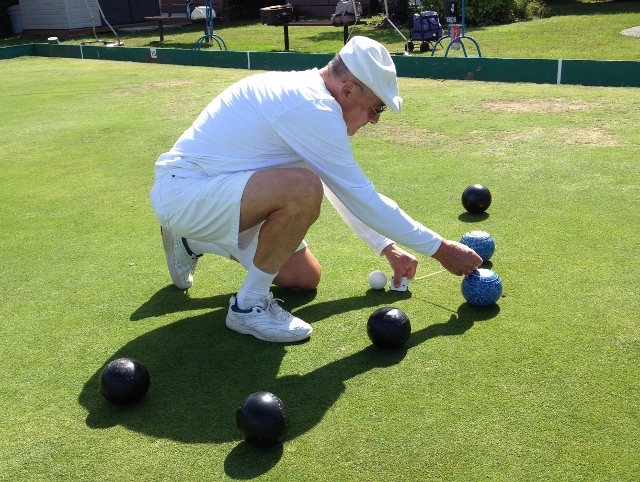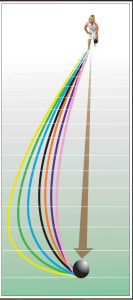
Red has “shot bowl” on rink 13 at the Oak Bay Lawn Bowling Club
2022-12-13 Updated link to the latest copy of the Laws of the Sport Version 4
This page is for those who are unfamiliar with the ancient game of bowls . . .
The object of the game is to get close to the jack
The object of lawn bowling is to roll up to four bowls per person to get your team’s bowls nearer than your opponents’ bowls to a small white or yellow ball called the “jack.”
The “green” is the field of play
The game is played on a carefully-tended, flat, grassy lawn, known as a “green.”
At our club, we divide each of our two 36-metre square greens into eight 4.5-metre “rinks.” No actual lines are drawn on the green to separate the rinks; there is only a white marker on the corner of each rink, mounted on the backboard. A rink number is centred between the markers. The end boundary of the rinks is a sand-filled trench known as “the ditch.”
Each rink can accommodate a game of bowls.
Bowls vary in size to suit the player
 Bowls vary in size to suit the player’s hand, ranging from 11.2-12.7 cm in diameter and 1.075-1.58 kg in weight, (or up to 5 inches and 3.5 pounds.) Sizes are marked on the bowls, and nowadays range from the smallest ‘0000’ up to ‘5’. There used to be a ‘6’ and a ‘7’ but those large bowls are no longer made – dropped in favour of extending the range downward to the new ‘000’ and ‘0000’ sizes.
Bowls vary in size to suit the player’s hand, ranging from 11.2-12.7 cm in diameter and 1.075-1.58 kg in weight, (or up to 5 inches and 3.5 pounds.) Sizes are marked on the bowls, and nowadays range from the smallest ‘0000’ up to ‘5’. There used to be a ‘6’ and a ‘7’ but those large bowls are no longer made – dropped in favour of extending the range downward to the new ‘000’ and ‘0000’ sizes.
Your set of four bowls will be marked with a distinctive emblem, so there is never a problem determining whose bowls are whose during a game.
Our club keeps a full range of bowls on hand to lend to new players. After a year of play, you will know what size you want to buy for yourself. A set of new bowls literally lasts a lifetime!
A game consists of many “ends”
The game starts with a player on one team rolling the jack along the rink and having it centred on the rink at the distance at which it came to rest, between 21 and 35 metres away from the “mat.”
The players on each team then roll their bowls alternately from the mat towards the jack until all have been delivered.
The score for that “end” is then calculated by counting all the bowls from one team that are closer to the jack than any bowls of the opponents. A typical score for an end would be one or two points, although it is possible to score as many points as your team has bowls.
A player from the team that won the previous end then rolls the jack in the reverse direction to start the second end. The game continues for the designated number of ends, with the score for each end being added to the scoreboard as the game progresses.
The typical friendly Daily Draw games at our club are six-person “triples” games of 14 ends, lasting about two hours.
Bowls curve . . .
The tricky part of the game is that the bowls do not run straight, but curve towards the jack. The players have to judge both the curve and the distance to the jack. Bowls may look symmetrical, but in fact they are “biased”; they bulge very slightly on one side, which makes that side heavier and causes the bowl to tip and curve more and more as it slows down. Manufacturers make different types of bowls; some curve more than others.
As the players build up the “head” of bowls, the game grows increasingly complex as bowls “wick” (ricochet) off each other as well as striking the jack. An end can change in an instant if the jack is struck and moved by a bowl. The focus of the game immediately shifts to the new jack location. The previous well-placed shots may then count for nothing.
Only the final positions of the bowls matter when the count for the end is made.
Lawn bowling has many variations
The game can be played as singles, pairs, triples or four-person teams. “Cutthroat” is a game for three players who all play against each other.
Cutthroat is an exception to the winner-takes-all scoring of the regular game. All three players can score in one end: three points for “shot” bowl; two for second shot; and one point for third closest.
Games of singles, pairs and cutthroat roll four bowls per player; triples players have three bowls each; fours players roll two bowls each.
There’s more to learn—or you can just go out and play!
To review the game and understand the scoring, watch Lawn Bowling 101, a three-minute video that covers the elements of the game.
Now that you have a good idea of how a game of bowls is played, you can find out everything you need to know about the rules by reading Laws of the Sport of Bowls. This is not a short read. After all, it rules on every conceivable situation that has occurred in 700 years of play!
There are a surprising number of specialized terms that lawn bowlers use during play, as shown in this glossary.
More than 300 books have been written about lawn bowling, which you can find at Books on Bowls. Here is one that is freely available online, Lawn Bowls Coaching by Rob Judson.
Once you have played a few times, you can improve your game with advice that you can find on our Player Development page.
And finally, here’s a video clip that tells you all about bowls and how they are made.
There you are! Now you are an (on screen) expert. May be time to try the game in real life at one of our Friday Visitors Nights.
The above description covers the dry facts of the game. What is not conveyed is the great pleasure that the bowlers derive from this elegant, ritualistic, social, competitive, challenging and — yes — beautiful game.
As Walt Disney once said:
“. . . there is a certain camaraderie among lawn bowlers not found in any other sport. It is excellent exercise, does not take a whole day of time, and good sportsmanship is always present. Millions of Americans, not just a few thousand, should be on the green, for once a person becomes a member of a club and gets on the green, he will find that his future will be filled with untold pleasures . . . and many added years.”
Fortunately, it is no great problem for you to follow Walt’s exhortation and “become a member of a club.” You’ll find your future untold pleasures in the corner of Carnarvon Park in Oak Bay. If you came by almost any day of the year around 2:00 p.m. you would find members either playing on the green or engaged in some game indoors. Just ask any one of them how you can become a member. If you can spare a dollar a day, you’re in!






